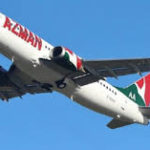All Boeing Co. 737 Max flights around the world are being tracked by U.S. regulators who are keeping watch on the plane after its 20-month grounding, using Aireon satellite network, which tracks the flights across the globe.
Bloomger reported that the Federal Aviation Administration is using a network of satellites capable of tracking planes in even the most remote regions as if they were under surveillance by local radars, according to the agency. The data is being provided by Virginia-based Aireon LLC, the FAA said in an emailed statement on Friday.
Aireon, which reached an agreement in November to provide the FAA with expanded flight data, is tracking Max flights for unusual events, such as rapid descents, said Vincent Capezzuto, the company’s chief technology officer. The monitoring began Jan. 29, Capezzuto said during a Feb. 12 webinar hosted by Aviation Week.
“Recently, we engaged with them on a 737 Max monitor,” he said. “You can literally monitor it on a situational awareness display.”
If any unusual events occur on the plane, “safety engineers and inspectors will use the early notification to further analyze the incident,” the FAA said.
The Max was grounded worldwide in March 2019 after a second fatal crash in less than five months. The two incidents caused the deaths of 346 people. The FAA required extensive redesigns of the plane’s flight-control systems. Other regulators, such as the European Aviation Safety Agency, have also begun lifting the flight ban.
Aireon was formed in 2012 by Iridium Communications Inc. and Nav Canada, a nonprofit company that guides air traffic in Canada. A constellation of 66 satellites monitor radio beacons from aircraft, providing tracking data that is equivalent to existing ground stations.
The system is helping nations including Canada and the U.K. track planes over the ocean.
Within weeks of the Aireon system going live, its data was used by U.S. officials, before they’d entered into an agreement with the company, to justify grounding the Max after other nations had done so. The Ethiopian Airlines jet that crashed March 10, 2019, wasn’t tracked by local radar, but the Aireon system showed its flight path in detail.







